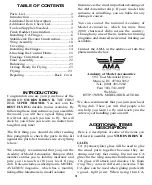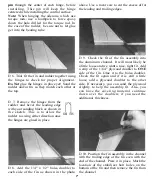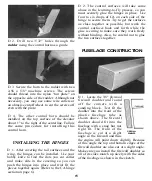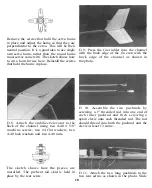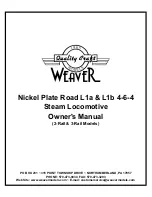
assemble the parts first and then add the
glue. It will penetrate the joint and cure in a
couple of seconds. Thick and medium CAs
are applied to the parts before they are
assembled since the glue will not cure for
20-30 seconds. This longer curing time gives
you more time to get the parts assembled
accurately before the glue cures. The thicker
consistency also helps fill poor fitting joints.
CA accelerator spray can be very handy
for speeding up the curing process of the
thick CAs.
Epoxy is a two-part adhesive that has to be
mixed before it will cure. We will use epoxy
glue for the wing assembly since it takes a
little longer to cure and does not attack the
foam. Epoxies come in several different types
with many different curing times. You should
buy some epoxy with a 30-minute curing
time for use here.
ENGINE
The STURDY BIRDY II is designed to fly with
a standard .20 size 2-stroke engine. The OS
.20 FP is a great, inexpensive engine that
provides plenty of power. This combination is
ideal for the average beginner. A .25 - .30 size
engine can be used if you would like snappier
performance, especially at higher elevations
where the air is thinner. We recommend that
you do not use an engine larger than a .30
as the additional weight makes the plane
more difficult to fly at low speeds. The engine
mount provided with the STURDY BIRDY II
will fit most .20 - .30 engines.
RADIO
The STURDY BIRDY II requires 4 channels to
fly. The radio system you purchase should
have standard size servos so they will fit into
the fuselage channel. Mini or micro servos will
also work but they will require some
modifications to fit properly. Large servos will
not work in the STURDY BIRDY II.
FUEL TANK
The STURDY BIRDY III was designed to hold
a 6 oz. square tank. A 4 oz. tank will also
work but will give you shorter flight times.
COVERING
Although not absolutely necessary, the "tail
feathers" and the wing should both be
covered with a "low heat" type iron on
covering. EconoKote^ and Black Baron® Film
are both good coverings to use on your
STURDY BIRDY II. The covering will not
only make your plane look nicer, but it will
also add strength and make it last longer.
CHECK LIST OF ADDITIONAL
ITEMS YOU WILL NEED
D .20 -.30 2-Stroke Engine
D 4 Channel Radio
D 4 Standard Size Servos
D Several 9 X 4 or 9 X 6 Propellers
D 2-1/2" Wheels (2)
D 6 oz. Square Fuel Tank
D Box #64 Rubber Bands
D Thin CA (Cyanoacrylate) Glue loz.
D Thick CA (Cyanoacrylate) Glue loz.
D 30-Minute Epoxy 4oz.
D Roll of Low Heat Iron-On Covering
D Foam Rubber for Cushioning Receiver
D 12" Standard Size Fuel Tubing
D 3/4" Wide Nylon Reinforced Tape
Questions or Problems?
Contact us at:
Hobby Services
Attn: Service Department
1610 Interstate Drive
Champaign, IL 61821-1067
(217) 398-8970
4



